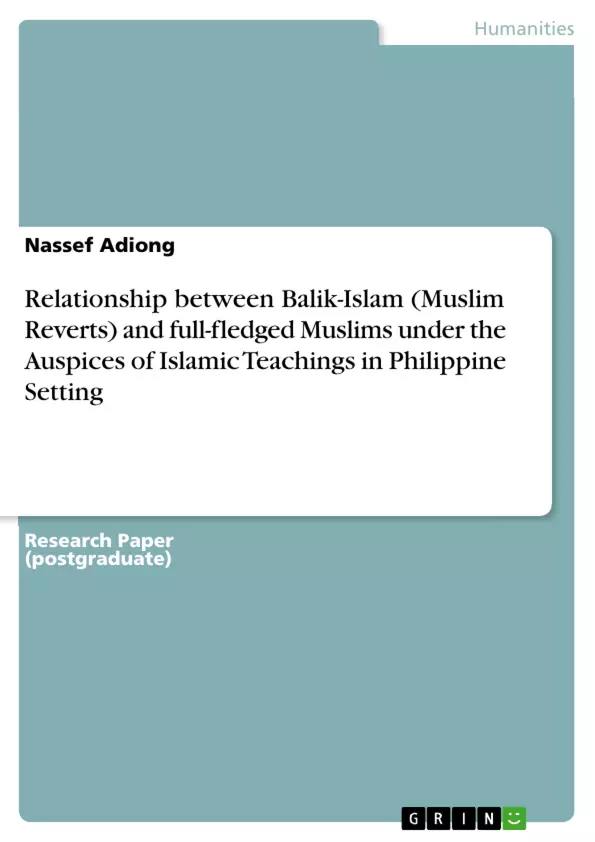
Relationship between Balik-Islam (Muslim Reverts) and full-fledged Muslims under the Auspices of Islamic Teachings in Philippine Setting
Forschungsarbeit, 2007
12 Seiten, Note: A+
Leseprobe
Table of Contents
- Anecdotal Introduction
- Abstract
- A Brief Balik-Islam Introductory Situation in the Philippines
- A Concise Look in the History of Islam in the Philippines
- What are you investigating? Why?
- What have others done within the subject area?
- Discussions to Answer the Posited Research Problem
- Which part of that body of knowledge your paper will be added to?
- Work Cited and Sources
Objectives and Key Themes
This empirical paper aims to explore the relationship between Balik-Islam (Muslim converts) and full-fledged Muslims in the Philippines, examining this relationship through the lens of Islamic teachings. The study utilizes both personal narratives and a questionnaire-based survey to achieve its objective.
- The experiences and perceptions of Balik-Islam in the Philippines.
- The integration of Balik-Islam within existing Muslim communities.
- The role of Islamic teachings in shaping the relationship between Balik-Islam and established Muslims.
- The impact of conversion on the identities and roles of women within the Balik-Islam community.
- Historical context of Islam in the Philippines and its influence on contemporary dynamics.
Chapter Summaries
Anecdotal Introduction: This introductory section details the researcher's journey in conceptualizing the paper, highlighting the challenges faced in defining its anthropological focus. It emphasizes the researcher's background in Islamic studies and Middle Eastern affairs and reveals the final research question: examining the relationship between Balik-Islam and full-fledged Muslims in the Philippines within the context of Islamic teachings. The introduction provides a personal and reflective perspective on the research process, foreshadowing the methodology and the overall direction of the study.
Abstract: The abstract outlines the study's methodology, which involves comparing the perspectives of a full-fledged Muslim and a Balik-Islam on Islamic theology and the contemporary situation of Muslims in the Philippines, utilizing Sakili's model of Muslim space. It also details the second part of the methodology, involving a questionnaire administered to a sample of 10 respondents from both groups. The abstract serves as a succinct overview of the two core components of the research, highlighting the approach and anticipated outcome.
A Brief Balik-Islam Introductory Situation in the Philippines: This section provides an overview of the Balik-Islam movement in the Philippines, estimating its membership at 200,000. It discusses the geographical distribution of converts, many of whom converted while working abroad, particularly in the Middle East. The chapter emphasizes the impact of conversion on women's identities and roles, highlighting how their new religious understanding shapes their perceptions of themselves and their relationships with family and society. The role of organizations like CONVISLAM in supporting Muslim converts is also discussed, along with the challenges faced by Balik-Islam, such as accusations of terrorism. The section sets the stage for understanding the contemporary context of Balik-Islam in the Philippines.
A Concise Look in the History of Islam in the Philippines: This chapter explores the various theories surrounding the arrival of Islam in the Philippines, ranging from Muslim traders establishing trade centers to forced conversions and the natural attraction to Islamic brotherhood. It traces the spread of Islam from the 13th to the 16th centuries, highlighting the establishment of sultanates and the integration of Islam with existing local practices. The chapter also details the impact of Spanish and later American colonization on the Muslim population, discussing the suppression of Islam and the subsequent efforts to strengthen the Muslim community in the Southern Philippines in the post-colonial era, touching on modern Moro nationalism and concerns about terrorism.
Keywords
Balik-Islam, Muslim converts, Philippines, Islamic teachings, Muslim community, religious identity, gender roles, conversion narratives, interfaith relations, Moro nationalism, Islam in Southeast Asia.
Frequently Asked Questions: A Study on Balik-Islam in the Philippines
What is the main focus of this research paper?
This research paper explores the relationship between Balik-Islam (Muslim converts) and full-fledged Muslims in the Philippines, examining this relationship through the lens of Islamic teachings. It investigates the experiences, perceptions, and integration of Balik-Islam within existing Muslim communities, considering the role of Islamic teachings and the impact of conversion on identities and roles, especially for women.
What methodologies are used in this study?
The study employs a mixed-methods approach. It utilizes personal narratives to gain in-depth understanding of individual experiences and a questionnaire-based survey administered to a sample of 10 respondents (5 Balik-Islam and 5 full-fledged Muslims) to gather broader perspectives. The research also draws on existing scholarly literature and historical context.
What are the key themes explored in the paper?
Key themes include the experiences and perceptions of Balik-Islam in the Philippines; their integration within existing Muslim communities; the role of Islamic teachings in shaping the relationship between Balik-Islam and established Muslims; the impact of conversion on the identities and roles of women within the Balik-Islam community; and the historical context of Islam in the Philippines and its influence on contemporary dynamics.
What is the historical context provided in the paper?
The paper provides a concise look at the history of Islam in the Philippines, exploring theories surrounding its arrival, its spread from the 13th to 16th centuries, the impact of Spanish and American colonization, and the subsequent efforts to strengthen the Muslim community in the post-colonial era, including modern Moro nationalism and concerns about terrorism.
What is the significance of the Balik-Islam movement in the Philippines?
The paper highlights the Balik-Islam movement in the Philippines, estimating its membership at 200,000. It discusses the geographical distribution of converts, many of whom converted while working abroad, particularly in the Middle East. The study emphasizes the impact of conversion on women's identities and roles and the challenges faced by Balik-Islam, such as accusations of terrorism. The role of organizations like CONVISLAM in supporting Muslim converts is also discussed.
What is the overall objective of the research?
The primary objective is to understand the relationship dynamics between Balik-Islam and full-fledged Muslims in the Philippines within the framework of Islamic teachings. The research aims to shed light on the integration process, challenges faced, and the impact of conversion on individual identities and community dynamics.
What are the key words associated with this research?
Balik-Islam, Muslim converts, Philippines, Islamic teachings, Muslim community, religious identity, gender roles, conversion narratives, interfaith relations, Moro nationalism, Islam in Southeast Asia.
What is the structure of the paper?
The paper is structured with an anecdotal introduction, an abstract, a section on the Balik-Islam situation in the Philippines, a section on the history of Islam in the Philippines, a discussion answering the research problem, and a section on cited sources. Chapter summaries are provided.
Details
- Titel
- Relationship between Balik-Islam (Muslim Reverts) and full-fledged Muslims under the Auspices of Islamic Teachings in Philippine Setting
- Hochschule
- Technological University of the Philippines (Islamic studies)
- Veranstaltung
- for college papers
- Note
- A+
- Autor
- Researcher Nassef Adiong (Autor:in)
- Erscheinungsjahr
- 2007
- Seiten
- 12
- Katalognummer
- V121031
- ISBN (eBook)
- 9783640253975
- Dateigröße
- 457 KB
- Sprache
- Englisch
- Schlagworte
- Islam Muslim Balik-Islam Muslim Reverts Muslim Converts The Philippines Filipino Bangsamoro Moro Maranaw Nassef M. Adiong
- Produktsicherheit
- GRIN Publishing GmbH
- Preis (Ebook)
- US$ 15,99
- Arbeit zitieren
- Researcher Nassef Adiong (Autor:in), 2007, Relationship between Balik-Islam (Muslim Reverts) and full-fledged Muslims under the Auspices of Islamic Teachings in Philippine Setting, München, Page::Imprint:: GRINVerlagOHG, https://www.diplomarbeiten24.de/document/121031
- Autor werden
- Ihre Optionen
- Vertriebskanäle
- Premium Services
- Autorenprofil
- Textarten und Formate
- Services für Verlage, Hochschulen, Unternehmen

- © GRIN Publishing GmbH.
- Alle Inhalte urheberrechtlich geschützt. Kopieren und verbreiten untersagt.
- info@grin.com
- AGB
- Open Publishing
Der GRIN Verlag hat sich seit 1998 auf die Veröffentlichung akademischer eBooks und Bücher spezialisiert. Der GRIN Verlag steht damit als erstes Unternehmen für User Generated Quality Content. Die Verlagsseiten GRIN.com, Hausarbeiten.de und Diplomarbeiten24 bieten für Hochschullehrer, Absolventen und Studenten die ideale Plattform, wissenschaftliche Texte wie Hausarbeiten, Referate, Bachelorarbeiten, Masterarbeiten, Diplomarbeiten, Dissertationen und wissenschaftliche Aufsätze einem breiten Publikum zu präsentieren.
Kostenfreie Veröffentlichung: Hausarbeit, Bachelorarbeit, Diplomarbeit, Dissertation, Masterarbeit, Interpretation oder Referat jetzt veröffentlichen!
- GRIN Verlag GmbH
-
- Nymphenburger Str. 86
- 80636
- Munich, Deutschland
- +49 89-550559-0
- +49 89-550559-10
- info@grin.com
-









